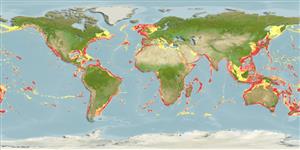Common names from other countries
Classification / Names / Names
Nomi Comuni | Sinonimi | Catalog of Fishes (gen., sp.) | ITIS | CoL | WoRMS
Environment: milieu / climate zone / depth range / distribution range
Ecologia
Benthopelagico; distribuzione batimetrica 0 - 2200 m (Ref. 275). Subtropical; 10°C - 24°C (Ref. 275), preferred 25°C (Ref. 107945); 79°N - 48°S, 180°W - 180°E
Circumglobal in subtropical and polar oceanic waters.
Length at first maturity / Size / Peso / Age
Maturity: Lm ?, range 40 - ? cm Max length : 45.0 cm ML maschio/sesso non determinato; (Ref. 97142); 90 cm ML (female); Peso massimo pubblicato: 1.8 kg (Ref. 275); Età massima riportata: 1.00 anni (Ref. 77103)
Caught by dipnets (Ref. 417). Maximum depth from Ref. 59712. Oceanic but occurs near the surface at night (Ref. 417). Occasionally washed up on the beaches (Ref. 88739).
Life cycle and mating behavior
Maturità | Riproduzione | Deposizione | Uova | Fecundity | Larve
Members of the class Cephalopoda are gonochoric. Male and female adults usually die shortly after spawning and brooding, respectively. Mating behavior: Males perform various displays to attract potential females for copulation. During copulation, male grasp the female and inserts the hectocotylus into the female's mantle cavity where fertilization usually occurs. Life cycle: Embryos hatch into planktonic stage and live for some time before they grow larger and take up a benthic existence as adults.
Roper, C.F.E., M.J. Sweeney and C.E. Nauen. 1984. (Ref. 275)
IUCN Red List Status (Ref. 130435)
CITES status (Ref. 108899)
Not Evaluated
Not Evaluated
Human uses
Pesca: commerciale
FAO - pesca: landings | FishSource | Sea Around Us
Strumenti
Fonti Internet
Estimates based on models
Preferred temperature
(Ref.
115969): 5.7 - 17.2, mean 10.4 (based on 1723 cells).
Prior r = 0.51, 95% CL = 0.34 - 0.76, Based on 1 full stock assessment.
